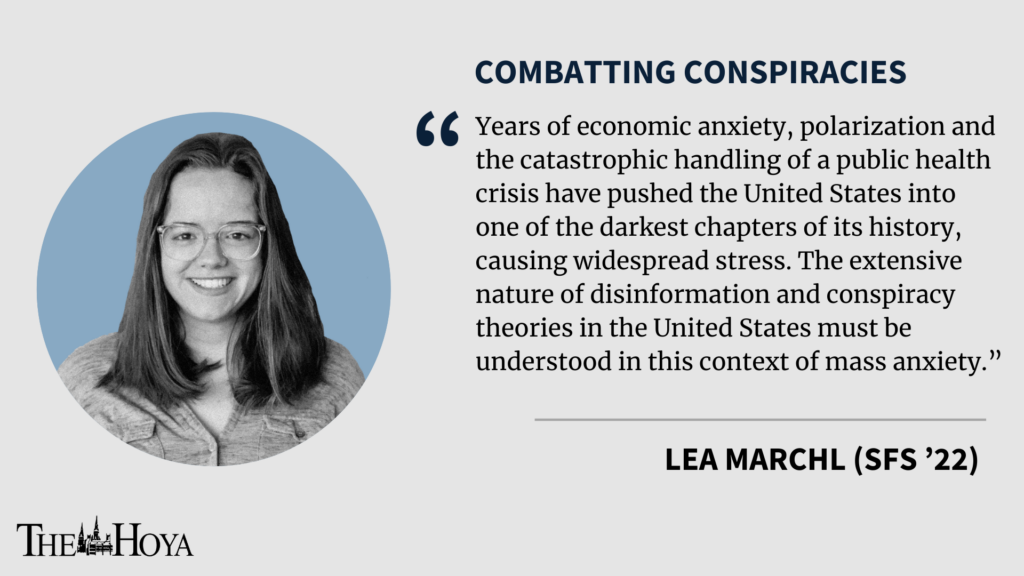The United States is in the midst of a media and information crisis that has allowed millions of Americans to choose their preferred versions of reality at a great detriment to public discourse and democratic norms. Historians and political scientists will spend future decades asking how a country like the United States could fall into such mass delusion, and part of their conclusion will hopefully recognize that conspiracy cults are coping mechanisms for difficult times.
Years of economic anxiety, polarization and the catastrophic handling of a public health crisis have pushed the United States into one of the darkest chapters of its history, causing widespread stress. The extensive nature of disinformation and conspiracy theories in the United States must be understood in this context of mass anxiety.
Several metrics indicate the United States is not as strong as it claims to be. While most other high-income countries’ life expectancies rise to new heights, U.S. life expectancy has been on the decline since 2014, despite being the highest spender on healthcare per capita. Over the last two decades, fatal drug overdoses for people in midlife have risen by 386.5%; suicide rates have increased by 38.3% for people ages 25 to 64 and by 55.9% for people ages 55 to 64. At the same time, wages adjusted for inflation have barely risen in twenty years, even as the cost of living has increased. Most importantly, income and wealth inequality is rising to levels not seen since the Great Depression. Work by Peter Turchin, a leader in the study of history using mathematical and statistical analysis, argues that when inequality rises, periods of political malaise and violence begin.
The already present inequity and anxiety in the United States have been exacerbated by the COVID-19 pandemic. The past year has seen an inconceivable amount of disease and death, the second once-in-a-generation economic meltdown in twelve years and a necessary reckoning with systemic racism that shook the nation’s psyche. Simply said, the misery and shock of 2020, in all their iterations, have left millions believing their country has gone off the rails.
Historically, people have turned to conspiracy theories in times when change was abundant and anxieties ran high. “The Protocols of the Elders of Zion,” first published in Russia in 1903 but popularized at the end of World War I, was a forgery claimed to be notes from a meeting of Jewish community leaders that laid out detailed plans for global domination. The clearly fabricated, antisemitic text is full of contradictions, but it was still used to justify pogroms in Russia and antisemitic policies across Europe and the United States, and it eventually became a source Hitler used to justify the genocide of the Jewish people during the Holocaust.
“The Protocols” was so successful because it offered a complete and easy explanation for everything wrong at the time. In the fallout of WWI, it explained why empires were collapsing, why influenza was spreading and why inflation was happening; it gave people a scapegoat for their troubles. Its sensationalist nature is similar to QAnon, a modern-day conspiracy that manages to tie every recent U.S. crisis to a massive cabal seeking to eliminate personal freedoms and the United States as we know it.
As such, QAnon has unsurprisingly thrived in 2020. The movement is designed as a way for followers to feel self-empowered, because they are in charge of creating the narrative. The movement encourages its followers to conduct their own research and choose the parts that go into a big tent theory. QAnon integrates current events into a false narrative that sensationalizes them, allowing followers to draw their own worldviews into a constantly evolving plot that paints the world in a very black-and-white manner. QAnon supporters encourage each other to add to each theory, fostering a culture in which very little is too outrageous. Ultimately, the followers are in charge of what QAnon is and, as such, can claim some control back from the story this country tells itself.
Furthermore, QAnon’s motto is “where we go one, we go all,” emphasizing QAnon is, above all, a community. Followers are extremely welcoming to new believers and will often discuss personal turmoil and their growing sense of alienation from their families and friends. They feel disrespected because their loved ones do not take their claims about a corrupt United States seriously, and thus, the online community provides validation and support. Moreover, many have embraced this experience as the pandemic sent most Americans home to be on their computers all day.
The American people are in pain, and conspiracy cults that present an altered reality to their followers act as a coping mechanism during a time of turmoil. People who subscribe to QAnon ideology prefer to believe some coordinated power is conspiring against the people, rather than accept the more simple reality that Americans are currently facing immense tragedy amid rising inequality and the COVID-19 pandemic.
Georgetown University students, despite having the privilege of an excellent education, are not immune to the turbulences of our times. As young, 20-somethings set to graduate in an unpredictable economy with burdensome debts, we are also susceptible to the psychological reprieve conspiracy theories offer. As we inherit the crisis of conspiratorial thinking, let us understand conspiracy cults are, in part, a byproduct of the times we live in, while also emphasizing that following them will do nothing to actually solve the systemic defects that have caused the problem in the first place.
Lea Marchl is a junior in the School of Foreign Service. Combatting Conspiracies appears online every other Friday.










Agen Bandarq • Feb 11, 2021 at 10:31 pm
Thank you, I’ve recently been searching for information about this subject for a long time and yours is the best I’ve found out so far.
However, what about the bottom line? Are you positive about the supply?